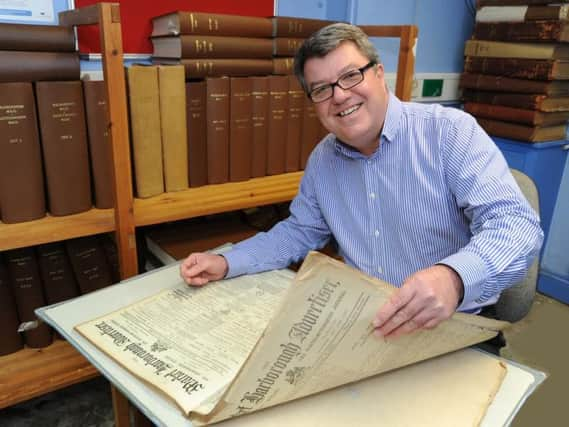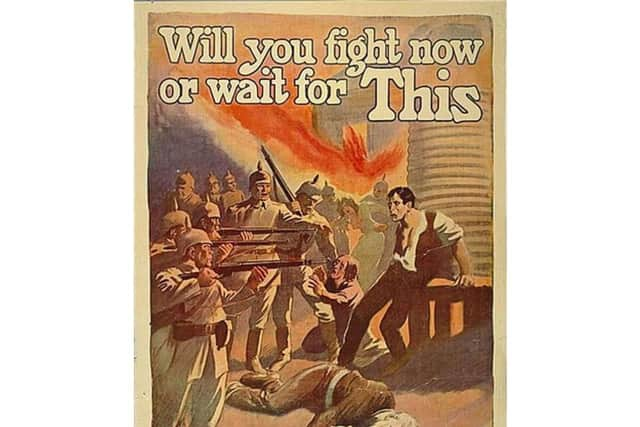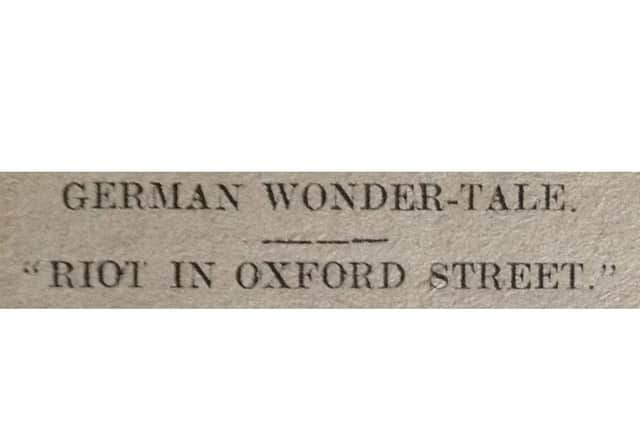John's real-time WW1 blog: Advertiser joins in mockery of the naive German propaganda machine


Admiralty chiefs it seems are swapping bullets for belly laughs in waging their war against Germany according to a front-page story in the February 12, 1918, edition of the Market Harborough Advertiser.
Headlined German Wonder-Tale, the story ridicules the naive German press reports that there are riots in London’s Oxford Street, policemen run away scared from the angry crowds, and soldiers are arrested after downing rifles because they refuse to fire upon their countrymen.
Advertisement
Hide AdAdvertisement
Hide AdWith the benefit of a hundred years of hindsight, it might seem the Germans have merely swapped the street names of revolutionary Moscow for London but it demonstrates just how clever the British propaganda machine works in turning enemy reports against themselves.


And it does it with typical self-effacing British humour. The story begins by calling the enemy account an ‘extraordinary specimen of the fabrications with which the German public is fed by its Government’.
Apparently, a wireless transmission by Berlin radio began: “During the whole of January the strikes in England have led to numerous riots and scenes in the streets. Hardly a day passed during this month without the crowd coming into conflict with the police in English towns.”
The German broadcast then quotes their ‘Amsterdam correspondent’ who says: “On January 17 at 3pm there was a conflict between the police and the crowd in which the police had the worst of it and were put to flight.”
Advertisement
Hide AdAdvertisement
Hide AdThe German reporter’s mockery does not stop there. He continues: “Then a detachment of Scotch recruits who were in barracks at Sheper-bush(Shepherd’s Bush?) were summoned to their assistance.”


The quizzical brackets after the clearly inaccurate place name in the Advertiser’s story are, of course, designed to turn the tables on the German correspondent and ridicule him.
The journalist continues with his breathless account. “When the soldiers reached Oxford Street where the principal fighting between the crowd and the police took place and the soldiers were ordered to fire, the majority of them refused and about 870 men were arrested and taken to the prison of the Old Bailey.
“At Selfridge’s great shop in Oxford Street all the windows were broken in the riot and in the evening there were other tumults in Threadneedle Street.”
Advertisement
Hide AdAdvertisement
Hide AdThe story concludes with the voice of the Advertiser now rather than the Amsterdam correspondent: “There is only one accurate point in this story. It is that Messrs Selfridge’s premises are actually situated in Oxford Street.”


That final paragraph is designed to ram home the message of humiliation – the Germans are so badly off they have to resort to these sorts of lies. And the underlying message is this: we British would never stoop so low as to make up propaganda to dupe the public.
This is, of course, is rubbish, as we now know, and many people in the provinces also knew at the time. For instance, in December 1914 the government set up a committee, under the chairmanship of James Bryce, a respected academic and member of the House of Lords, to investigate allegations of brutality by German forces in Belgium.
The publication of The Report of the Committee on Alleged German Outrages – better known as the Bryce report – was widely reported and was seen as a major propaganda victory for the allies.
Advertisement
Hide AdAdvertisement
Hide AdCosting 1d, the price of a newspaper, this 360-page pamphlet contained a ‘summary of evidence’ and an appendix – of some 300 pages – of selected case histories which described the execution of civilians, the torture and mutilation of Belgian women, the bayoneting of small children and just about every atrocity that could be committed by German soldiers.


The Daily Mail and other national newspapers carried these sensational stories but there was not a shred of evidence to support the claims. And it was independently proven well after the war – when it didn’t matter.
Phillip Knightley, the author of The First Casualty, a renowned book about war correspondents, says: “A Belgian commission of enquiry in 1922, when passions had cooled, failed markedly to corroborate a single major allegation in the Bryce Report. By then, of course the report had served its purpose. Its success in arousing hatred and condemnation of Germany makes it one of the most successful propaganda pieces of the war.”
In fact Knightley argues that the British developed ‘a propaganda machine that became the envy of the world’ and ‘by the end of the war had created a propaganda organisation that became the model on which Goebbels based that of the Germans some 20 years later’.
Advertisement
Hide AdAdvertisement
Hide AdDespite this rather humorous story the Advertiser carries accounts of waging the war that have more immediate and intimate consequences.
The Great Easton family of Private Harold Baker have finally been officially notified he is dead – it has taken nine months to take him off the ‘missing’ list where he had been since the battle of Vimy Ridge in April 1917. And the Laughton family of Private Harry Atkins have been told he has died of his wounds. Atkins spent more time in hospital than he did on the battlefield.
- This column is published every Monday by John Dilley on the Newspapers and the Great War website and will continue until the 100 th anniversary of the final armistice in November 2018.- My fellow researcher and De Montfort University lecturer David Penman is conducting a similar real-time project with the Ashbourne Telegraph. Check out his Great War Reports.
- Check out this week’s Harborough Mail for current news from the Market Harborough area.